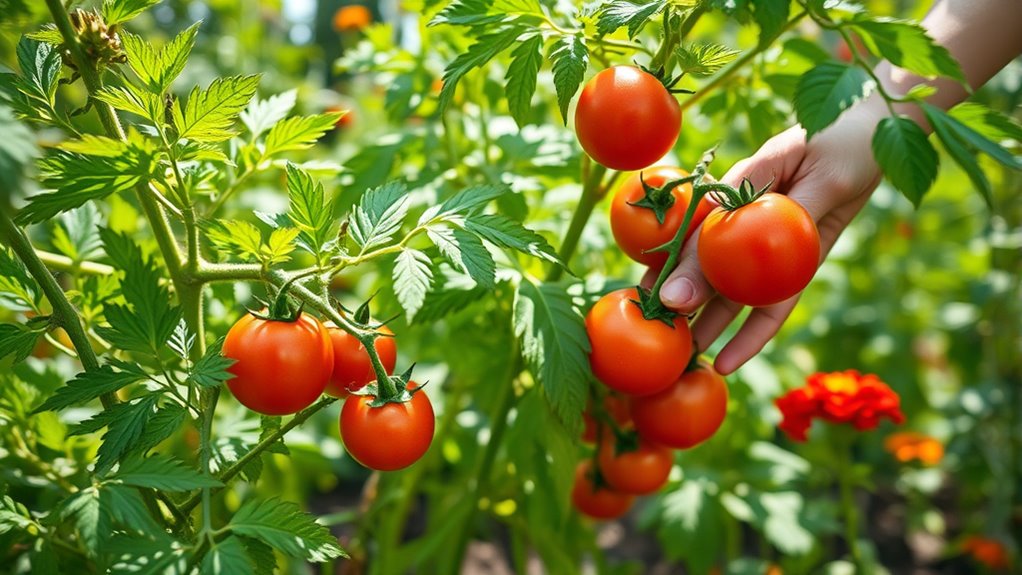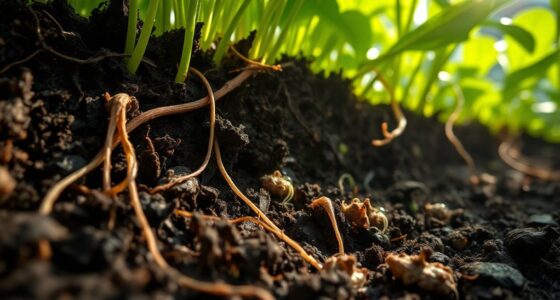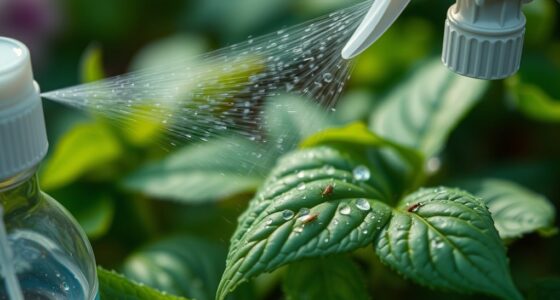Integrated Pest Management (IPM) helps you control pests by combining regular monitoring, natural predators, preventive practices, and minimal chemical use. It focuses on understanding your garden’s needs and using eco-friendly methods to keep pests in check. By working smarter, not harder, you protect your plants and the environment at the same time. If you want to learn more about creating a healthy, resilient garden with IPM, you’re in the right place.
Key Takeaways
- IPM combines cultural, biological, and chemical methods to manage pests effectively with minimal environmental impact.
- It emphasizes regular pest monitoring to detect problems early and prevent unnecessary pesticide use.
- Biological controls like beneficial insects are used to naturally reduce pest populations safely.
- Prevention strategies such as resistant plants and crop rotation are prioritized to reduce pest issues.
- The goal is sustainable pest management that protects plant health and promotes a balanced, eco-friendly garden.

Ever wonder how to keep pests under control without relying solely on chemicals? That’s where integrated pest management (IPM) comes in. IPM is a smart, sustainable approach that combines different strategies to manage pests effectively while minimizing environmental impact. Instead of jumping straight to pesticides, you focus on understanding your garden’s unique needs and using a mix of methods to keep pests in check. It’s about working smarter, not harder, to protect your plants and the environment.
Discover smart, eco-friendly pest control with integrated pest management for healthier gardens.
One of the cornerstones of IPM is pest monitoring. This involves regularly inspecting your garden to identify pest presence and damage early. By keeping a close eye on your plants, you can detect problems before they become severe. Pest monitoring helps you decide when action is necessary, avoiding unnecessary treatments that could harm beneficial insects or lead to pesticide resistance. It’s like becoming a detective for your garden—spotting signs of trouble early lets you act with precision and confidence.
Biological controls are another fundamental part of IPM strategies. These involve using natural enemies—like ladybugs, lacewings, or beneficial nematodes—to manage pest populations. Biological controls are a safe, eco-friendly alternative to chemical pesticides. By introducing or encouraging these beneficial organisms, you create a balanced ecosystem where pests are kept in check naturally. For example, releasing ladybugs can help control aphids without harming your other plants or beneficial insects. Biological controls work best when combined with pest monitoring, so you know exactly when and where to introduce these helpful allies.
In practice, IPM emphasizes a layered approach. You start with prevention—such as selecting resistant plant varieties, practicing crop rotation, and maintaining healthy soil—to make your garden less attractive to pests. If pests appear, pest monitoring guides you on whether they’re at a damaging level. If intervention is needed, biological controls are your first line of defense. Only if these methods don’t suffice do you consider targeted, minimal use of chemical controls, and even then, only as a last resort. This approach reduces chemical use, which is better for your garden’s health, beneficial insects, and the environment.
Ultimately, IPM isn’t about eliminating pests entirely but managing them in a way that’s sustainable and effective. By combining pest monitoring with biological controls and other practices, you create a resilient garden ecosystem. It’s a proactive, informed way to protect your plants, ensuring they thrive without the overuse of chemicals. With patience and attention, you’ll develop a balanced garden that’s healthier, more productive, and kinder to the planet.
Frequently Asked Questions
How Do I Start Implementing IPM in My Garden?
To start implementing IPM in your garden, first identify pests and monitor plant health regularly. Use biological controls like beneficial insects to naturally reduce pests. When necessary, choose chemical alternatives carefully, opting for least-toxic options. Keep your garden healthy by maintaining proper watering and fertilizing, and remove debris. This proactive approach helps you manage pests effectively while minimizing environmental impact, creating a balanced, thriving garden ecosystem.
Are There Specific Pests That IPM Can’t Control?
You might think IPM can handle everything, but surprisingly, some pests like invasive species or resistant ones slip through. Chemical controls often fail against these tough invaders, and relying solely on IPM won’t always solve the problem. You need to stay vigilant, use targeted methods, and sometimes combine strategies. Remember, no pest management system is perfect, especially when nature throws unexpected challenges your way.
What Are the Costs Associated With IPM?
When considering the costs of IPM, you should do a thorough cost analysis and budget planning. IPM often involves initial investments in monitoring tools, biological controls, and training, but it can reduce long-term pesticide expenses. While some methods may seem costly upfront, they often save money over time by preventing pest outbreaks. You’ll find that careful planning helps balance the costs with the benefits of healthier, pest-resistant gardens.
How Do I Identify Pest Thresholds Effectively?
Think of your garden as a delicate dance where pest thresholds are your rhythm guide. You spot pest density creeping up and compare it with damage levels on your plants. If pests start to outweigh the harm they cause, it’s time to step in. Regular monitoring helps you recognize these signs early, so you can act just before pests overwhelm your crops, keeping the dance balanced and healthy.
Can IPM Be Used Alongside Organic Gardening Practices?
You can definitely use IPM alongside organic gardening practices, as they’re highly compatible. IPM emphasizes organic methods like biological controls and cultural practices, avoiding chemical conflicts. By choosing organic-approved solutions and monitoring pests carefully, you maintain organic integrity while effectively managing pests. This approach helps protect your garden’s health and supports sustainable, chemical-free gardening, ensuring you stay aligned with organic standards while controlling pests efficiently.
Conclusion
So, next time you’re battling pests, remember that traditional sprays aren’t the only answer. With IPM, you get to play detective, gardener, and peacekeeper all at once—without turning your garden into a chemical wasteland. Ironically, the best way to protect your plants is often to do less and think smarter. Who knew that patience, observation, and a little effort could keep pests at bay better than endless chemical warfare? Happy gardening—smart, sustainable, and pest-free!









